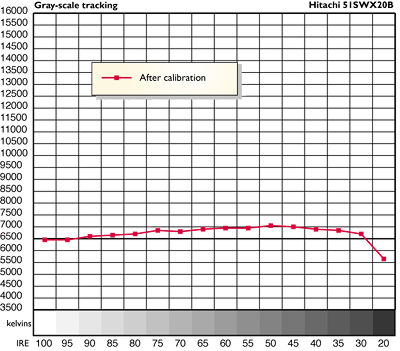Hitachi 51SWX20B HD-ready CRT projection television Calibration

You'll see that there is no pre-calibration gray-scale curve in the accompanying figure. That's because, as delivered, all three of the Hitachi 51SWX20B's color-temperature settings, except at the low and high ends of the brightness range, measured "off the chart." That is, our Photo Research meter would not register a color temperature. At the low end (20 IRE), the Standard setting measured 3200 kelvins; at the high end (100 IRE), 7350K. The Medium setting measured 3650K at the low end (20 IRE) and 10,000K at the high (100 IRE). And the Cool setting measured 11,500K at 30 IRE. At all other settings, the meter would not provide a temperature reading, which means that the result is far removed from the D6500 standard.
After I'd calibrated the set (in the Standard setting), however, the result was far better. While I had to accept a slightly elevated temperature in the mid-brightness range to avoid low values at the top and bottom, the result was generally more than acceptable. The light output from the set, after calibration and resetting the Contrast and Brightness controls for the best picture, measured 29 foot-Lamberts. (This 29f-L value was obtained with a Contrast setting of 11 and a Brightness setting of 48, though individual set and calibration differences may mean that these are not necessarily the optimum settings for all samples.)
The actual color points of the phosphors were quite accurate in the red and blue, but green was shifted slightly toward yellow. The deviation was not obvious on normal program material.
The gray-scale settings are global; that is, one setting applies to all inputs and aspect ratios. The user video adjustments provide reference numbers for the settings, and the menu item selected for adjustment drops down to the bottom of the screen so you can observe the results. One minor problem is that several of the adjustments do not provide every step; that is, only every other number is offered over part of the range. When fine-tuning program material, I often wished for those in-between settings, particularly with the Brightness control.
The PLUGE pattern was unusually sharp. There were some visible reflections on this test (the familiar crescent moon in the left half of the image), but they were less obvious than on most rear-projection sets I've seen. Horizontal resolution on DVD was over 525 lines. The convergence, once properly set, was relatively stable, though it did profit from occasional touchup. The luminance sweep pattern (Video Essentials, chapter 17-23) showed some emphasis above about 4.5MHz, indicating a little peaking in the set above this frequency. The emphasis could not be eliminated by turning the Sharpness control all the way down.
The decoder tests on the Avia test CD showed a red push of about 25%. But this could be adjusted out in the service menu. Even afterward, however, I found that a slight reduction in the Color control, to about 35, often resulted in a better picture.
The onboard scaler produced occasional artifacts with average-quality standard-definition broadcasts, but no more so than I've seen from other sets. With DVDs, artifacts were rarely visible. A few jagged edges appeared on the ship's railings in Titanic. In the opening scenes on Star Trek: Insurrection, the haystacks looked fairly good, though not completely artifact-free. The pan across the rooftops in the village, however, was unusually clean and free of artifacts. The waving flag on the Faroudja test DVD showed some subtle but visible jaggies, and the 3:2 pulldown test on the same disc revealed that the Hitachi's scaler recognized 3:2 pulldown, but had difficulty maintaining the pulldown once it acquired a lock.
Overscan measured an average of about 4% on all sides in 4:3. In the 4:3 expanded mode, this increased to 9% each on top and bottom and 5.5-6% at the sides. The 16:9 mode overscanned by 4.5% top and bottom and 6% left and right.—TJN
- Log in or register to post comments






























































